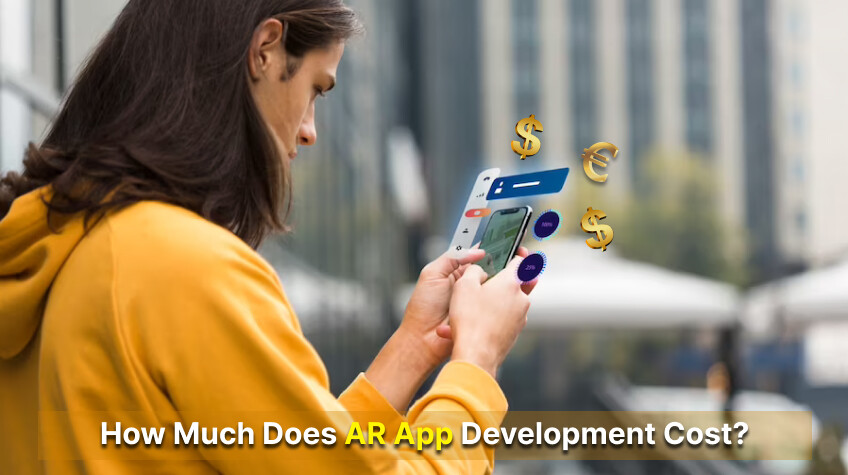
In a world where technology continuously evolves, Augmented Reality (AR) has emerged as a groundbreaking innovation that blurs the line between the physical and digital realms. As businesses and individuals strive to leverage the power of AR, one question arises: How much does AR app development cost? Delving into this realm requires navigating a complex landscape where creativity meets cutting-edge technology.
From conceptualizing immersive experiences to crafting intuitive user interfaces, AR app development demands a unique blend of technical expertise and artistic vision. So, let’s embark on a journey to unravel the cost considerations associated with bringing enchanting AR experiences to life as we explore the dynamic intersection of imagination and reality.
What is an Augmented Reality app?
Imagine a world where the boundary between what’s real and what’s virtual becomes beautifully blurred. Enter augmented reality apps, the captivating gateways to immersive experiences that fuse digital elements seamlessly with our physical surroundings. With these innovative applications, our smartphones, tablets, or even smart glasses become portals to a realm where imagination and reality intertwine.
Augmented reality apps captivate our senses and spark our curiosity by guiding us through complex tasks with overlaid instructions to adding a touch of whimsy to our selfies with interactive filters. Whether we’re exploring virtual creatures in a real-world setting or unveiling hidden layers of information, these magical apps create a harmonious association between technology and our everyday lives.
How Content Influences Augmented Reality App Development Cost
Regarding augmented reality app development, the type of content you want to incorporate significantly determines the overall cost. It is important to note that different types of content have different levels of complexity and production requirements.
For instance, incorporating videos into AR experiences can be cost-effective, allowing you to share information or create engaging advertisements. On the other hand, integrating 3D models into the real environment provides a visually captivating experience, making it suitable for product launches or brand promotions. However, developing high-quality 3D models can increase the overall cost.
Animation takes AR to the next level by introducing interactive and dynamic elements. It adds complexity to the development process, impacting the final price. Lastly, 360-degree videos offer an immersive experience but require meticulous planning and production, resulting in higher costs. Considering the type of content you want to integrate into your AR app is crucial as it directly influences the complexity of development and, consequently, the overall cost.
Cost of Augmented Reality App
When estimating the cost of AR development, it’s essential to consider various factors influencing the final price. A simple AR application can range from $7,000 to $50,000, depending on its complexity and features. However, for more intricate projects with complex structures, content, and systems, the cost can escalate to around $200,000. Augmented reality games, known for their complexity, can start from $250,000 and go even higher.
Furthermore, the location of the development team can affect costs. Specialists from the USA and Canada typically command higher hourly rates, ranging from $100 to $250. Western European experts may charge up to $150 per hour, while those from Eastern Europe ask between $25 and $100, depending on experience. Specialists from Asia offer a more budget-friendly option, with rates of up to $55 per hour. Remember to evaluate these aspects while designing your AR project budget.
What are the types of Augmented Reality Apps?
1. Marker-based AR
Marker-based AR is a captivating and widely used approach in the vast realm of Augmented Reality (AR) apps. This type of AR depends on particular markers or images as triggers to unlock a world of digital wonders. By harnessing the power of computer vision, these apps can recognize and track predefined markers, seamlessly overlaying virtual content onto them.
Imagine pointing your device’s camera at a marker and witnessing a static image emerge, transforming it into a dynamic 3D object or an interactive experience. Marker-based AR finds applications in gaming, marketing, education, and even bridging the physical and digital art gap. It merges the physical and virtual realms, captivating users with its ability to transform ordinary objects into extraordinary gateways of imagination.
2. Markerless AR
In the ever-evolving landscape of Augmented Reality (AR) apps, Markerless AR emerges as a fascinating and liberating approach. Unlike its marker-based counterpart, Markerless AR transcends the need for specific markers or triggers, opening up a world of limitless possibilities. By leveraging the power of GPS, compass, and advanced computer vision algorithms, Markerless AR apps seamlessly integrate digital content into real-world environments.
From interactive location-based experiences that guide us through unfamiliar cities to informative overlays that enrich museum visits, Markerless AR captivates our senses without constraints. It liberates us from the reliance on markers, allowing AR to seamlessly blend with our surroundings and elevate our everyday interactions to extraordinary heights.
3. Projection-based AR
In Augmented Reality (AR) apps, Projection-based AR emerges as a captivating and transformative experience. This innovative approach brings digital content to life by projecting it onto real-world objects or surfaces. Using specialized projectors or displays, Projection-based AR creates a mesmerizing fusion of the physical and virtual realms. Imagine walking into a room and seeing animated characters spring to life, interactive elements projected onto furniture, or immersive visual effects enhancing architectural spaces.
Projection-based AR opens a world of creative possibilities, enchanting audiences with its ability to reshape and reimagine physical environments, turning them into dynamic canvases of imagination and wonder. It transcends traditional boundaries, transforming ordinary spaces into extraordinary stages for captivating AR experiences.
4. Superimposition-based AR
Step into the realm of Augmented Reality (AR) apps, where Superimposition-based AR takes center stage as a truly captivating experience. With its advanced object tracking capabilities, this approach seamlessly integrates digital content onto real-world objects, creating an enchanting fusion of the physical and virtual. Imagine pointing your device at a simple coffee mug and witnessing it come alive with vibrant animations or contextual information floating around it.
Superimposition-based AR adds an extra layer of depth and interactivity to our surroundings, unlocking a world of limitless possibilities. The boundaries between real and augmented are blurred, inviting us to explore and interact with the magic that lies beyond our senses.
5. Recognition-based AR
In the enchanting realm of Augmented Reality (AR) apps, Recognition-based AR stands as a captivating and awe-inspiring experience. This remarkable approach harnesses the power of computer vision algorithms to recognize and track specific objects, patterns, or even facial expressions in real time.
By seamlessly integrating virtual content with recognized elements, Recognition-based AR creates personalized and interactive experiences that leave us spellbound. Picture a world where your device can identify and animate everyday objects, overlay information on artworks in a gallery, or transform your face into a whimsical character. Recognition-based AR unlocks a realm where the boundaries between reality and imagination dissolve, offering a mesmerizing journey of discovery and wonder.
6. AR browsers
In the dynamic world of Augmented Reality (AR) apps, AR browsers emerge as fascinating gateways to immersive experiences. These innovative tools function as augmented reality web browsers, allowing users to access various AR content directly from their devices. AR browsers provide a platform where developers can create and share captivating AR experiences, ranging from 3D models and animations to interactive elements.
Picture exploring a city and discovering hidden historical facts, virtual guides, and even augmented art installations simply by pointing your device around. AR browsers transform our devices into portals of discovery, blending the digital and physical realms seamlessly and captivatingly, offering us a new lens through which to view the world.
7. The complexity of the AR app
Regarding AR app development, the project’s complexity is critical in defining the general price. Generally, the more intricate and layered the AR experience, the more time and effort it takes to create. Developers must carefully design and align multiple elements to achieve the desired visual effects and interactions.
Further, it’s crucial to evaluate the longevity of the project. Creating a one-time model or animation is quicker than building and maintaining a long-lasting AR solution. Projects with lasting value require ongoing updates, bug fixes, and improvements to keep them relevant and engaging for users.
For example, AR games exemplify complex AR projects’ intricate nature. The process demands meticulous effort, from strategizing and plot development to creating captivating visuals and analyzing user feedback. However, the result is often a unique and immersive experience that captivates and entertains users in extraordinary ways.
Related Post: What is Cross Platform Metaverse Development
How Long Does it Take to Build an Augmented Reality App?
The timeline for building an augmented reality (AR) app can change relying on many aspects. On average, it takes around 291 hours to develop an AR app. However, the duration can range from as few as 133 hours for more straightforward projects to as many as 533 hours for more complex ones.
Your app’s specific requirements and complexity determine how long it will take to develop. Custom designs, niche features, and non-standard release platforms may add extra time to the development process. Communicating your specific needs and working closely with the development team to establish a realistic timeline for your AR app project is essential.
Challenges of Building an Augmented Reality Application
Building an augmented reality (AR) application, especially a gaming app, comes with challenges. Legal and reputational risks are significant concerns, including the potential infringement of intellectual property rights and the addictive nature of gaming experiences. Gaming apps must implement parental controls to safeguard against unauthorized purchases by children.
Compliance with laws governing online gambling or gambling devices is also vital, and obtaining necessary gambling licenses in applicable jurisdictions may be required. To protect user data, gaming apps should prioritize robust reporting mechanisms for platform abuse and conduct regular security audits to prevent unauthorized access. Addressing these challenges ensures a safer and more responsible AR gaming experience.
Which Industries can be Targeted with AR Apps?
Augmented Reality (AR) apps have the capability of revolutionizing numerous industries, bringing immersive experiences and innovative solutions. Here are some sectors that can be targeted with AR apps:
- Education: AR apps can enhance learning by overlaying interactive textbook information, creating virtual simulations, and offering immersive educational experiences.
- Retail: AR can provide virtual try-on experiences, personalized shopping recommendations, and interactive product demonstrations, enhancing the overall retail experience.
- Healthcare: AR apps can aid in medical training, surgery simulations, and patient education by overlaying anatomical models and real-time data on patient scans.
- Architecture and Real Estate: AR allows architects and real estate professionals to showcase virtual models, simulate interior designs, and provide immersive property walkthroughs.
- Tourism and Hospitality: AR apps can offer interactive city guides, historical tours, and virtual travel experiences, enhancing tourism and hospitality services.
- Manufacturing and Maintenance: AR apps can provide remote assistance, overlay assembly instructions, and aid in equipment maintenance, reducing downtime and improving efficiency.
These are just a few examples, but the possibilities for AR app integration extend to numerous industries, each with unique opportunities for enhancing experiences and driving innovation.
In conclusion, the cost of AR app development varies depending on several factors, such as the project’s complexity, the type of AR development, and the desired features and functionality. While a simple AR app can cost around $10,000, more complex applications can range from $20,000 to $200,000 or higher. Additionally, the development team’s location and specialists’ hourly rates play a role in determining the overall cost.
It’s crucial to carefully plan and consider these factors when budgeting for AR app development. By understanding the cost considerations, businesses and individuals can embark on the exciting journey of bringing captivating AR experiences to life.






